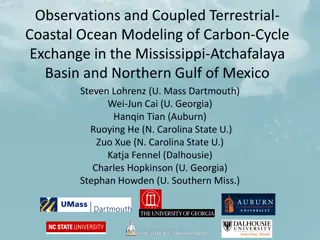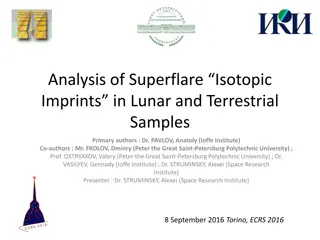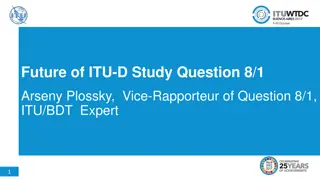Experience The Purity Tuberose Essential Oil Pure Therapeutic Aromatherapy 30 Ml
Health Benefits of Tuberose Essential Oil\n\nThe various medicinal properties of this essential oil are as follows.\n\nAphrodisiac: Justifying its romantic and sensual names that include \u201cNight Queen\u201d and \u201cMistress of the Night\u201d, this oil behaves as an aphrodisiac. It is commonly
0 views • 4 slides
Advancements in Solar-Terrestrial Research and Meteorology
The Solar-Terrestrial Centre of Excellence (STCE) focuses on ongoing activities and opportunities in the field of meteorology, with a special emphasis on Antarctica. Their annual meetings cover topics like water vapor feedback mechanisms, extreme weather events forecasting, cloud and precipitation s
0 views • 14 slides
Understanding Water Management: Principles, Practices, and Soil-Water Relations
Explore the principles and practices of water management in agriculture with a focus on water availability, nutrient relationships, and losses. Discover the physical classification of water, available water defined between field capacity and wilting point, soil water potential, and the soil-plant-at
6 views • 17 slides
Influence of Solar Activity and Orbital Motion on Terrestrial Atmosphere
Solar magnetic field reversal, wavelet spectral analysis, and proxies for solar activity index are discussed in relation to the joint effects of solar activity and solar orbital motion on the Earth's atmosphere. The study highlights the impact of solar cycles on terrestrial climate dynamics and temp
6 views • 16 slides
Understanding the Carbon Cycle: Reservoirs, Dynamics, and Importance
Earth's carbon cycle plays a crucial role in sustaining life, with carbon moving through various reservoirs and processes. This cycle involves short-term terrestrial and marine cycles, as well as long-term cycles influenced by volcanic activity and rock weathering. Understanding carbon reservoir dyn
6 views • 45 slides
The Role of Sunlight, Ozone, and Plant Life in Earth's Atmosphere
Sunlight plays a crucial role in the formation of ozone from oxygen, leading to the protection of plant life against harmful UV radiation. The ozone produced by sunlight helps in the photosynthesis process of plants, which in turn release oxygen, absorb CO2, and contribute to the overall balance of
7 views • 23 slides
Global and Local Winds
Global and local winds are created by differences in air pressure due to unequal heating of the atmosphere. Wind formation involves the movement of air from high to low pressure areas, influenced by factors like the Coriolis effect. The composition, structure, and properties of the atmosphere play c
9 views • 34 slides
NASA Atmosphere Observing System (AOS) Overview
NASA's Atmosphere Observing System (AOS) comprises innovative technologies and instruments to study aerosol, cloud, convection, and precipitation processes. AOS includes the AOS-Storm and AOS-Sky missions, utilizing various sensors like radars, lidars, radiometers, and polarimeters to address key at
0 views • 13 slides
Understanding Earth's Water Cycle and Atmospheric Processes
Explore the intricate workings of Earth's water cycle and atmospheric processes, including the distribution of water across various reservoirs, the significance of humidity in the atmosphere, and the influence of temperature on water vapor content. Gain insights into global wind patterns, pressure s
2 views • 42 slides
Why Flowers Are Essential for Creating a Beautiful Wedding Atmosphere
Wedding flowers have an undeniable charm that can transform any venue into a magical setting. From bouquets to centerpieces, flowers play a vital role in creating a beautiful and romantic atmosphere for your special day. Their symbolism, colors, and fragrance all contribute to the overall ambiance o
0 views • 4 slides
Earth-GRAM Overview and Updates 2023
Earth-GRAM is a global reference atmospheric model providing monthly mean and standard deviation data for various atmospheric variables. It is used in engineering for dispersion simulations but is not a forecasting model. Updates to Earth-GRAM include the Modern Era Retrospective Analysis, a global
0 views • 19 slides
Understanding Atmosphere Composition and Structure in Climatology
The study of climatology, focusing on the atmosphere, is presented by Dr. Banashree Saikia, covering topics such as atmospheric composition, insolation, temperature variations, atmospheric pressure, wind systems, atmospheric moisture, climatic classification, cyclones, and monsoons. The atmosphere,
1 views • 9 slides
Eerie Atmosphere: Unveiling Mysterious Settings
Dive into the world of creating atmosphere and tension in writing by exploring the use of descriptive language, figurative expressions, and sensory details. Learn how to craft a mysterious and spooky atmosphere in a story through vivid descriptions and emotive vocabulary, as exemplified in a deserte
0 views • 6 slides
Understanding Environmental Hygiene: Air Pollution and Composition of Air
The content delves into the concept of atmospheric pollution, the composition of pure and impure air, sources of air pollution, and the zones of the atmosphere. It highlights the detrimental effects of pollutants on health and the environment, emphasizing the importance of environmental hygiene. The
1 views • 27 slides
Understanding Tone, Mood, and Atmosphere in Literature
Atmosphere, mood, and tone are essential elements in literature that shape the emotional tone of a literary work, influence reader expectations, and convey the author's attitude. They are interconnected yet distinct aspects that add depth and complexity to storytelling. This analysis delves into the
0 views • 12 slides
Proposal for Enhancing Security in RRC Connection Setup Procedure
Study the security mechanisms to secure the RRC connection setup process for the exchange of sensitive information between authentic network elements (BS and AMF) even before UE authentication. Addressing the lack of security in RRC Msg5 is crucial for various functionalities like Network Slicing an
1 views • 4 slides
Understanding Environmental Factors in Terrestrial and Aquatic Environments
Environmental factors play a crucial role in shaping ecosystems. In both terrestrial (land) and aquatic (water) environments, organisms are influenced by abiotic factors such as temperature, light intensity, and pH, as well as biotic factors like plants, predators, and competitors. Understanding the
4 views • 19 slides
Understanding Gases and Plasmas in the Atmosphere
Delve into the concepts of gases and plasmas in the atmosphere, exploring topics such as fluid pressure, buoyancy, and the unique properties of gases compared to liquids. Discover how the balance between kinetic energy and gravity determines the thickness of our atmosphere and why it is essential fo
0 views • 25 slides
Principles of Atmospheric Flight in Aeronautics
This material covers essential topics in aeronautics including the physical properties of the atmosphere, standard atmosphere relationships, Mach number theory, lift and drag principles, stability, control, pressure and temperature variations based on location and solar activity, and the Internation
0 views • 22 slides
Coupled Ocean-Atmosphere Modeling on Icosahedral Grids
Coupled ocean-atmosphere modeling on horizontally icosahedral and vertically hybrid-isentropic/isopycnic grids is a cutting-edge approach to modeling climate variability. The design goals aim to achieve a global domain with no grid mismatch at the ocean-atmosphere interface, with key indicators such
1 views • 21 slides
Understanding the Nature and Importance of Earth's Atmosphere
Earth's atmosphere is a vital component that supports life on our planet. It is a thin gaseous envelope surrounding Earth, providing essential elements for living beings. The composition and development of the atmosphere have evolved over billions of years. The atmosphere plays a crucial role in pro
3 views • 14 slides
Understanding Gases in the Earth's Atmosphere
Explore the composition and layers of the Earth's atmosphere, including the significance of gases like nitrogen, oxygen, water vapor, and carbon dioxide. Learn how human activities impact atmospheric composition and how changes in temperature and pressure affect weather predictions. Discover the rol
0 views • 13 slides
Challenges and Opportunities of Georgia's Digital Terrestrial Switchover
The transition to digital terrestrial broadcasting in Georgia posed challenges such as lack of strategy and clear vision in 2012, but also highlighted opportunities like civil society involvement and donor support. Contrasting government and civil society models for digital infrastructure ownership
0 views • 9 slides
Coupled Terrestrial-Coastal Modeling of Carbon Exchange in the Gulf of Mexico
Explore the interactions between terrestrial and coastal systems in the Mississippi-Atchafalaya Basin and Northern Gulf of Mexico through coupled terrestrial-coastal ocean modeling. The study focuses on carbon dynamics, uncertainties in coastal carbon budgets, and the NASA IDS project's approach. Fu
3 views • 26 slides
Adaptations and Characteristics of Mammals in Terrestrial Environments
Mammals are well adapted to various terrestrial conditions, inhabiting water, air, and soil. They maintain a stable body temperature, have fur for temperature regulation and protection, and unique limbs for different modes of movement. The distinguishing features of mammals include fur, specialized
0 views • 39 slides
Omnispace: Redefining Global Mobile Connectivity with 5G NTN Technology
Omnispace, launching in December 2022, introduces the world's first global hybrid mobile network using 5G NTN technology to revolutionize mobile connectivity for consumer, enterprise, government, and IoT users. The innovative 5G hybrid architecture combines global NGSO coverage and mobile network ro
0 views • 10 slides
Understanding Atmosphere-Ocean Coupling in Madden-Julian Oscillation
Atmosphere-ocean coupled processes in the Madden-Julian Oscillation (MJO) play a crucial role in intraseasonal oscillations. This paper review by Shao Yun-Chuan explores how the ocean's Sea Surface Temperature (SST) influences surface fluxes, MJO convection, and energy balance dynamics. It delves in
0 views • 17 slides
Integrated Terrestrial-Coastal Ocean Framework for Carbon Management
An advanced framework integrating terrestrial and coastal ocean observations and modeling is developed to support carbon management decisions. The study focuses on assessing the impacts of land use, human activities, and climate scenarios on the carbon cycle, particularly dissolved inorganic carbon
0 views • 5 slides
Analysis of Superflare Isotopic Imprints in Lunar and Terrestrial Samples
Researchers investigate isotopic imprints in lunar and terrestrial samples to understand extreme solar events and their impact on atmospheric radiocarbon concentrations. Using 10Be and 36Cl data, they analyze the solar proton spectra and energy fluxes associated with these events, shedding light on
0 views • 13 slides
Soil Moisture-Atmosphere Interactions in the 2003 European Summer Heat Wave
This presentation discusses the significant impacts of soil moisture-atmosphere interactions during the 2003 European Summer Heat Wave, highlighting the abnormally hot weather, pavement buckling, and high-pressure systems that contributed to the extreme conditions. The images and diagrams illustrate
0 views • 27 slides
Understanding Earth's Atmosphere Composition and Layers
Earth's atmosphere is primarily composed of nitrogen and oxygen, with other gases like argon, CO2, and water vapor making up the remaining percentage. While the levels of nitrogen and oxygen remain constant, variable gases like water vapor fluctuate based on location and time. CO2 levels have been i
0 views • 53 slides
Assessing Forest Loss in Protected Areas: A Philippines Case Study
The study assesses forest cover loss in terrestrial protected areas of the Philippines, analyzing the extent and rate of deforestation using Hansen's Global Forest Cover Change datasets. The research aims to understand the drivers of deforestation in protected areas, comparing forest loss in the ent
0 views • 24 slides
Composition of the atmosphere
The atmosphere is a mixture of gases, with 78% nitrogen, 21% oxygen, and the remaining 1% comprising various gases like carbon dioxide, helium, argon, neon, and hydrogen. Water vapor, an essential component, influences humidity and plays a crucial role in weather patterns. Through gravity, the atmos
0 views • 7 slides
Terrestrial ECVs: Fire, Land Cover, Soil Moisture Overview
Detailed examination of Terrestrial Essential Climate Variables (ECVs) focusing on fire monitoring, land cover analysis, and soil moisture assessment. The information encompasses product summaries, error characterization methods, outreach efforts, user statistics, planned activities for phase 2, and
0 views • 8 slides
Understanding Atmospheric Composition and Structure
The presentation covers fundamental concepts related to the Earth's atmosphere, including its composition, origin of oxygen, dry and moist layers, standard atmosphere layers, and temperature variations. Key topics discussed include the primordial atmosphere, atmospheric constituents, water vapor dis
0 views • 58 slides
Evolution of Earth's Atmosphere and the Role of Plants in Oxygen Production
Earth's atmosphere has evolved over billions of years, with plants and algae playing a crucial role in producing oxygen through photosynthesis. This process gradually increased oxygen levels, enabling the evolution of animals. The reduction of carbon dioxide levels by plants absorbing it for photosy
0 views • 4 slides
Future of ITU-D Study Question 8/1 Report Analysis
This report delves into the impact of terrestrial television broadcasting coexisting with telecommunication services, focusing on the transition to digital terrestrial television. It covers strategies for analogue switch-off, spectrum planning, and digital dividend use. The report also includes case
0 views • 16 slides
Understanding Atmospheric Thermodynamics and Environmental Lapse Rate
Explore the concepts of atmospheric thermodynamics including the Parcel Method, Environmental Lapse Rate, and Conditionally Unstable Atmosphere. Dive into the details of how air parcels behave in different atmospheric conditions and understand the significance of temperature changes in the atmospher
0 views • 27 slides
C2.Link 5GHz Band Planning Overview
The C2.Link 5GHz Band Planning involves allocation to AM(R)S, AMS(R)S, and ARNS on a co-primary basis, with ICAO systems and MLS given priority. RTCA MOPS for a terrestrial C2 Link system and EUROCAE MOPS for a geostationary satellite-based system were released. The use of TDD waveforms in RTCA DO-3
0 views • 13 slides
Terrestrial File Transfer Concept: Design Goals and Protocols
This document discusses the concept of terrestrial file transfer as presented in a series of slides from an ESA event in Noordwijkerhout, The Netherlands. It covers the purpose, design goals, protocols, and transport protocols involved in exchanging files between agencies for mission design, operati
0 views • 20 slides







































